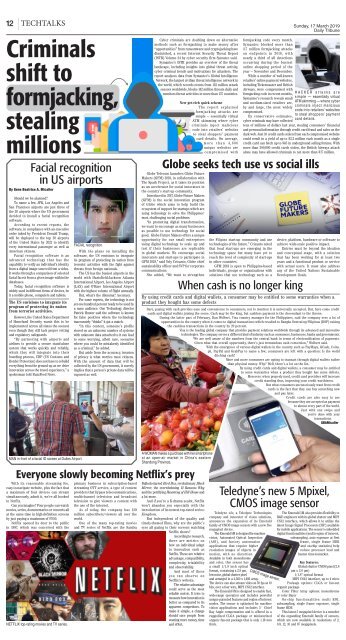17 MARCH 2019
You also want an ePaper? Increase the reach of your titles
YUMPU automatically turns print PDFs into web optimized ePapers that Google loves.
12 TECHTALKS Sunday, <strong>17</strong> March <strong>2019</strong><br />
Daily Tribune<br />
Criminals<br />
shift to<br />
formjacking,<br />
stealing<br />
millions<br />
Facial recognition<br />
in US airports<br />
By Gene Beatrice A. Micaller<br />
Should we be alarmed?<br />
To name a few, JFK, Los Angeles and<br />
San Francisco airports are just three of<br />
the 20 airports where the US government<br />
decided to install a facial recognition<br />
software.<br />
According to recent reports, the<br />
software, in compliance with an executive<br />
order inked by President Donald Trump,<br />
will be deployed to the top 20 airports<br />
of the United States by 2021 to identify<br />
every international passenger as well as<br />
American citizens.<br />
Facial recognition software is an<br />
advanced technology that has the<br />
capability to verify an individual’s identity<br />
from a digital image sourced from a video.<br />
It works through a comparison of selected<br />
facial facets from a given image within the<br />
databases.<br />
Today, facial recognition software is<br />
widely used in different forms of devices, be<br />
it a mobile phone, computers and tablets.<br />
The US envisions to integrate its<br />
program of protecting its nation<br />
from terrorist activities.<br />
However, the United States Department<br />
of Homeland Security wants this to be<br />
implemented across all states the soonest<br />
even though they still lack proper vetting<br />
and regulatory safeguards.<br />
“By partnering with airports and<br />
airlines to provide a secure stand-alone<br />
system that works quickly and reliably,<br />
which they will integrate into their<br />
boarding process, CBP (US Customs and<br />
Border Protection) does not have to rebuild<br />
everything from the ground up as we drive<br />
innovation across the travel experience,” a<br />
spokesman told BuzzFeed News.<br />
FACIAL recognition.<br />
With the plans on installing the<br />
software, the US envisions to integrate<br />
its program of protecting its nation from<br />
terrorist activities with the fight against<br />
threats from foreign nationals.<br />
The US has the busiest airports in the<br />
world with Hartsfield-Jackson Atlanta<br />
International Airport, Los Angeles Airport<br />
(LAX) and O’Hare International Airport<br />
with the highest volume of flight annually.<br />
But, what’s the dilemma? Accuracy.<br />
For some experts, the technology is not<br />
yet one hundred percent ready to be used by<br />
a mass audience. One Technology director<br />
Patrick Hunter said the software is known<br />
for false positives where the technology<br />
inaccurately “thinks” it got a match.<br />
“In this context, someone’s profile<br />
stored on an unknown number of systems<br />
with unknown data attached to it can lead<br />
to some worrying, albeit rare, scenarios<br />
where you could be mistakenly identified<br />
as a criminal,” he added.<br />
But aside from the accuracy, invasion<br />
of privacy is what worries most citizens.<br />
With the amount of data that will be<br />
collected by the US government, it merely<br />
implies that a person’s private data will be<br />
exposed as well.<br />
Cyber criminals are doubling down on alternative<br />
methods such as formjacking to make money after<br />
“opportunities” from ransomware and cryptojacking have<br />
diminished, a recent Internet Security Threat Report<br />
(ISTR) Volume 24 by cyber security firm Symatec said.<br />
Symantec’s ISTR provides an overview of the threat<br />
landscape, including insights into global threat activity,<br />
cyber criminal trends and motivations for attackers. The<br />
report analyzes data from Symantec’s Global Intelligence<br />
Network, the largest civilian threat intelligence network in<br />
the world, which records events from 123 million attack<br />
sensors worldwide, blocks 142 million threats daily and<br />
monitors threat activities in more than 157 countries.<br />
Globe Telecom launches Globe Future<br />
Makers (GFM) <strong>2019</strong>, in collaboration with<br />
The Spark Project, as it takes its position<br />
as an accelerator for social innovators in<br />
the country’s start-up community.<br />
Introduced in 20<strong>17</strong>, Globe Future Makers<br />
(GFM) is the social innovation program<br />
of Globe which aims to help build the<br />
ecosystem of support for startups which are<br />
using technology to solve the Philippines’<br />
most challenging social problems.<br />
“In promoting digital transformation,<br />
we want to encourage as many businesses<br />
as possible to use technology for social<br />
good. Globe Future Makers offers a unique<br />
opportunity for our small enterprises<br />
using digital technology to scale up and<br />
test if their businesses are replicable<br />
in global markets. We encourage social<br />
innovators and start-ups to participate in<br />
GFM <strong>2019</strong>,” said Yoly Crisanto, Globe chief<br />
sustainability officer and SVP for corporate<br />
communications.<br />
She added, “We want to strengthen<br />
New get-rich quick scheme<br />
The report explained<br />
formjacking attacks are<br />
simple — essentially virtual<br />
ATM skimming where cyber<br />
criminals inject malicious<br />
code into retailers’ websites<br />
to steal shoppers’ payment<br />
card details. On average,<br />
more than 4,800<br />
unique websites are<br />
compromised with<br />
formjacking code every month.<br />
Symantec blocked more than<br />
3.7 million formjacking attacks<br />
on endpoints in 2018, with<br />
nearly a third of all detections<br />
occurring during the busiest<br />
online shopping period of the<br />
year — November and December.<br />
While a number of well-known<br />
retailers’ online payment websites,<br />
including Ticketmaster and British<br />
Airways, were compromised with<br />
formjacking code in recent months,<br />
Symantec’s research reveals small<br />
and medium-sized retailers are,<br />
by and large, the most widely<br />
compromised.<br />
By conservative estimates,<br />
cyber criminals may have collected<br />
the Filipino start-up community and use<br />
technologies of the future.” Crisanto noted<br />
that local start-ups are emerging in the<br />
technology space but many have yet to<br />
reach the level of complexity of start-ups<br />
in other countries.<br />
GFM <strong>2019</strong> is open to Philippine-based<br />
individuals, groups or organizations with<br />
solutions that use technology such as a<br />
tens of millions of dollars last year, stealing consumers’ financial<br />
and personal information through credit card fraud and sales on the<br />
dark web. Just 10 credit cards stolen from each compromised website<br />
could result in a yield of up to $2.2 million each month as a single<br />
credit card can fetch up to $45 in underground selling forums. With<br />
more than 380,000 credit cards stolen, the British Airways attack<br />
alone may have allowed criminals to net more than $<strong>17</strong> million.<br />
Globe seeks tech use vs social ills<br />
When cash is no longer king<br />
HACKER attacks are<br />
simple — essentially virtual<br />
ATM skimming — where cyber<br />
criminals inject malicious<br />
code into retailers’ websites<br />
to steal shoppers’ payment<br />
card details.<br />
device, platform, hardware or software to<br />
achieve wide-scale positive impact.<br />
Entries must be beyond the ideation<br />
and conceptual stage, with a solution<br />
that has been working for at least two<br />
years and a functional product or service<br />
with actual users. It must also address<br />
any of the United Nations Sustainable<br />
Development Goals.<br />
By using credit cards and digital wallets, a consumer may be entitled to some warranties when a<br />
product they bought has some defects<br />
Sure, paying with cash provides ease and convenience to consumers, not to mention it is universally accepted. But, here come credit<br />
cards and digital wallets joining the scene. Cash may be the king, but cashless payment is the descendant to the throne.<br />
During the latter part of February, Dan Wolbert, Visa country manager for the Philippines, said the company sees a lot of<br />
opportunities in the country when it comes to digital transactions which resulted to Bangko Sentral ng Pilipinas (BSP) raising<br />
the cashless transactions in the country by 20 percent.<br />
Visa is the leading global company that provides payment solutions worldwide through its advanced and innovative<br />
technologies. The company serves a different kind of industry such as consumers, businesses, banks and governments.<br />
“We are well aware of the numbers from the central bank in terms of electronification of payments.<br />
Given what that overall opportunity, there’s just tremendous cash conversion,” Wolbert said.<br />
With the emergence of various digital wallets in the country such as PayMaya, GCash, Coins.<br />
ph, PayPal and GrabPay to name a few, consumers are left with a question: Is the world<br />
ditching cash?<br />
More and more consumers are opting to transact through digital wallets rather<br />
than physical money. Why? Well, there’s a lot on the list.<br />
By using credit cards and digital wallets, a consumer may be entitled<br />
to some warranties when a product they bought has some defects.<br />
Moreover, when properly used, credit card providers will increase<br />
credit standing thus, improving your credit worthiness.<br />
But what consumers unconsciously want from credit<br />
cards is the fact that they can buy something now<br />
and pay later.<br />
Credit cards are also easy to use<br />
because they are accepted as payment<br />
to almost every part of the world.<br />
Just with one swipe and<br />
you’re done with your<br />
transactions.<br />
GBAMicaller<br />
MAN in front of a facial ID screen at Dulles Airport.<br />
Everyone slowly becoming Netflix’s prey<br />
With its reasonable streaming fee,<br />
easy-to-navigate website, plus the fact that<br />
a maximum of four devices can stream<br />
simultaneously, admit it, we’re all hooked<br />
to Netflix.<br />
Can you imagine? Four people can watch<br />
movies, series, documentaries or concerts all<br />
at the same time in high-definition screens<br />
by just paying a maximum of P550.<br />
Netflix opened its door to the public<br />
in 1997, which was conceived with the<br />
NETFLIX top-rating movies and TV series.<br />
primary business in subscription-based<br />
streaming OTT service, a type of content<br />
providers that bypass telecommunications,<br />
multichannel television and broadcast<br />
television to give viewers a content with<br />
the use of the internet.<br />
As of today, the company has 139<br />
million subscribers/viewers all over the<br />
world.<br />
One of the many top-rating movies<br />
and TV series of Netflix are the Sandra<br />
A WOMAN makes a purchase with her smartphone<br />
at an open-air market in China's eastern<br />
Shandong Province.<br />
Bullock-starred Bird Box, revolutionary Black<br />
Mirror, the overwhelming 13 Reasons Why<br />
and the petrifying Haunting of Hill House and<br />
a lot more.<br />
And if you’re a K-drama zealot, Netflix<br />
won’t abandon you especially with the<br />
introduction of its newest top-rated series:<br />
Kingdom.<br />
But independent of the quality and<br />
timely-themed films, why are the public’s<br />
eyes all gazing to their screens watching<br />
Netflix shows?<br />
According to research,<br />
there are metrics on<br />
how an individual adapt<br />
to innovation such as<br />
Netflix. These are relative<br />
advantage, compatibility,<br />
complexity, trialability<br />
and observability.<br />
And most of these<br />
you can observe on<br />
Netflix’s website.<br />
The relative advantage<br />
could serve as the most<br />
reliable metric. It tries to<br />
measure how innovation is<br />
better as compared to its<br />
apparent competitors. To<br />
make it simple, a change<br />
should save people from<br />
wasting more money, time<br />
and effort.<br />
Teledyne’s new 5 Mpixel,<br />
CMOS image sensor<br />
Teledyne e2v, a Teledyne Technologies<br />
company and innovator of vision solutions,<br />
announces the expansion of its Emerald<br />
family of CMOS image sensors with a new five<br />
megapixel device.<br />
The Emerald 5M is designed for machine<br />
vision, Automated Optical Inspection<br />
(AOI), and factory automation<br />
applications that require higher<br />
resolution images of objects in<br />
motion, with no distortion.<br />
Available in both monochrome<br />
and color, this sensor has<br />
a small 1/1.8 inch optical<br />
format, containing a 2.8 μm,<br />
low-noise, global shutter pixel<br />
and arranged in a 2,560 x 1,936 array.<br />
The device can also stream video at 50 fps at 10<br />
bits, over a four wire, MIPI CSI-2 interface.<br />
The Emerald 5M is designed to enable fast,<br />
wide-range operation and includes powerful<br />
unique patented features and region of interest<br />
modes. The sensor is optimized for machine<br />
vision applications and includes 5° Chief<br />
Ray Angle compensation and is offered in a<br />
ruggedized CLGA package or miniaturized<br />
organic fan-out package that is only 1.19 mm<br />
thick.<br />
CMOS image sensor.<br />
The Emerald 5M also provides flexibility to<br />
R&D engineers with its global shutter and MIPI<br />
CSI-2 interface, which allows it to utilize the<br />
latest Image Signal Processors (ISP) available<br />
for mobile applications. The sensor’s embedded<br />
digital functionalities (multi region of interest,<br />
subsampling, auto exposure at first<br />
frame, single frame HDR<br />
and on-chip statistics) help<br />
reduce processor load and<br />
hasten time-to-market.<br />
Key features:<br />
Global shutter CMOS pixel (2.8<br />
μm x 2.8 μm)<br />
1/1.8” optical format<br />
MIPI CSI-2 interface, up to 4 wires<br />
Package options: CLGA or fan-out<br />
organic package<br />
Color Filter Array options: monochrome<br />
or color Bayer<br />
On-chip functionalities: multi ROI,<br />
subsampling, single frame exposure, single<br />
frame HDR<br />
This latest 5 megapixel device is a member<br />
of the expanding Emerald family of sensors,<br />
which are now available in resolutions of 2,<br />
8.9, 12, 16 and 67 megapixels.


















